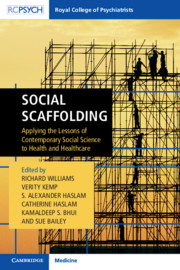Book contents
- Social Scaffolding
- Social Scaffolding
- Copyright page
- Contents
- Contributors
- Foreword
- Note
- Section 1 Schooling
- Section 2 Scoping
- Chapter 6 The Social Determinants of Mental Health
- Chapter 7 Laidback Science: Messages from Horizontal Epidemiology
- Chapter 8 Parity of Esteem for Mental Health
- Chapter 9 Belonging
- Chapter 10 Families and Communities: Their Meanings and Roles Across Ethnic Cultures
- Chapter 11 The Nature of Resilience: Coping with Adversity
- Chapter 12 The Value of Tolerance and the Tolerability of Competing Values
- Chapter 13 Towards Partnerships in Health and Social Care: A Coloquium of Approaches to Connectedness
- Chapter 14 Commentaries on Core Themes in Section 2
- Section 3 Sourcing
- Section 4 Scaffolding
- Section 5 Sustaining
- Index
- References
Chapter 9 - Belonging
from Section 2 - Scoping
Published online by Cambridge University Press: 14 June 2019
- Social Scaffolding
- Social Scaffolding
- Copyright page
- Contents
- Contributors
- Foreword
- Note
- Section 1 Schooling
- Section 2 Scoping
- Chapter 6 The Social Determinants of Mental Health
- Chapter 7 Laidback Science: Messages from Horizontal Epidemiology
- Chapter 8 Parity of Esteem for Mental Health
- Chapter 9 Belonging
- Chapter 10 Families and Communities: Their Meanings and Roles Across Ethnic Cultures
- Chapter 11 The Nature of Resilience: Coping with Adversity
- Chapter 12 The Value of Tolerance and the Tolerability of Competing Values
- Chapter 13 Towards Partnerships in Health and Social Care: A Coloquium of Approaches to Connectedness
- Chapter 14 Commentaries on Core Themes in Section 2
- Section 3 Sourcing
- Section 4 Scaffolding
- Section 5 Sustaining
- Index
- References
Summary
Attachment theory has become a central concept in our understanding of resilience in children and young people (Fonagy et al., 1994). However, attachment theory is a relatively narrow concept, focused on the relationship between a child and his or her principal caregivers and the child’s need to seek comfort when distressed (Waters et al., 2005). Furthermore, attachment theory concerns itself with individual person’s relationships, while recognising that children can have multiple attachment relationships. However, we know that children grow up in complex systems (Bronfenbrenner, 1979) and there is a growing recognition that children and young people’s sense of belonging (to individuals, groups and organisations) is a key component of resilience (Hart et al., 2008). Thus, the concept of belonging encapsulates children’s relationships with their immediate families or carers, their friends and their friends’ families, their schools, social activities (Scouts, football clubs, youth clubs) and wider social experiences, such as religious organisations or cultural groups.
- Type
- Chapter
- Information
- Social ScaffoldingApplying the Lessons of Contemporary Social Science to Health and Healthcare, pp. 72 - 77Publisher: Cambridge University PressPrint publication year: 2019
References
- 1
- Cited by



